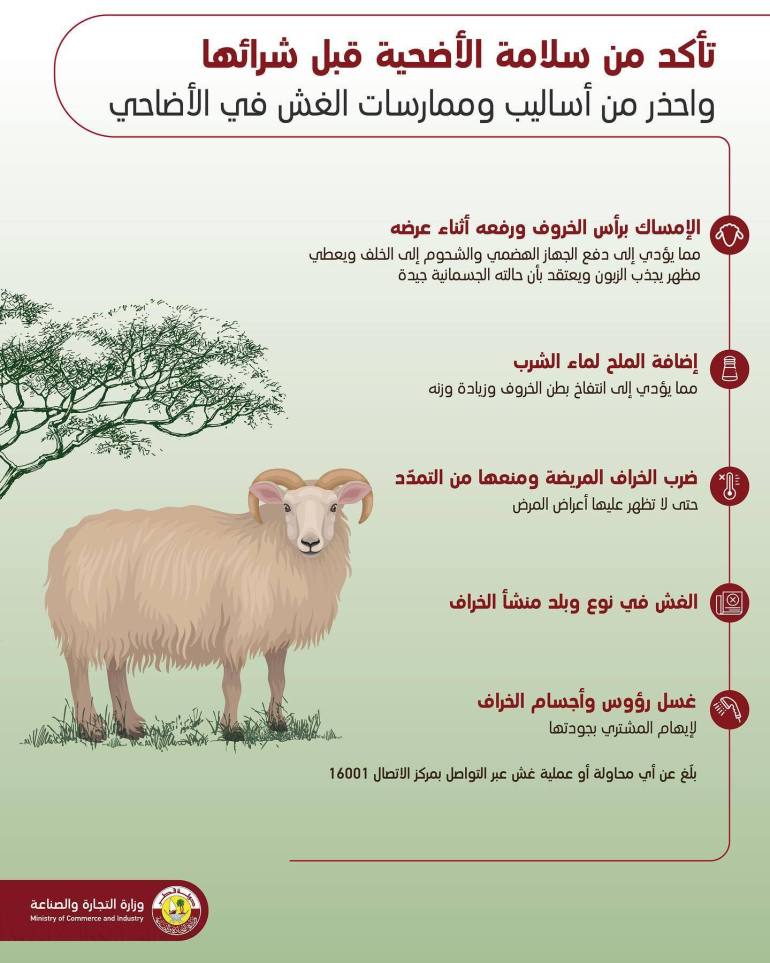How to choose the sacrifice in the feast so that it is free of diseases?
What are the diseases that may affect it?
The answers here, with a step-by-step explanation of how to choose the sacrifice, in detail, the infographic and the video, are comprehensive.
We start with the diseases that may affect livestock, the most prominent of which can be summarized as follows:
Diseases affecting sheep
There are many diseases that affect sheep into 3 groups, according to the Public Authority for Agriculture and Fisheries Affairs in Kuwait, such as stomach and intestine worms, scabies, sheep pox, tapeworms, ticks, anthrax, liver worms, lice, foot-and-mouth and lung worms.
Diseases affecting cows
According to the College of Veterinary Medicine at the University of Karbala in Iraq, there are many diseases that affect cows, such as leukemia, viral diarrhea, infectious rhinotracheitis, vesicular stomatitis, foot and mouth disease, rinderpest, dengue fever, anthrax and brucellosis.
Diseases affecting camels
According to Dr. Abdel Moneim Abdel Fattah Abdel Samee, Professor of Internal Medicine, at the Faculty of Veterinary Medicine at Cairo University, among the diseases that affect camels are Camel Pox, Rinder Pest, Foot & Mouth Disease, Anthrax and Inflammatory Bowel Disease or Salmonella.
Diseases affecting livestock first affect their health, and lead to lower specification of their meat as a result of disease.
There are also some diseases that affect livestock and are transmitted to humans, such as brucellosis, a bacterial disease caused by different types of Brucella bacteria.
We will move on to how to choose the sacrifice so that it is sound and in good health, according to the Ministry of Commerce and Industry in Qatar, which are:
The sacrificial animal must be sound in appearance and without wounds or blisters.
The lint or wool must be intact and not falling in some parts, as it is consistent and strong and cannot be removed easily, as the animal may be infected with external or internal parasites.
It must be ensured that there are no traces of diarrhea and that the animal dung is cohesive and in the form of small balls for sheep, and not soft, watery, dry or lean.
head check
Nose: It should be clean and moist and not have any secretions or sores.
Teeth: They must be healthy according to age, as they are milky until the age of 9 months, then the sacrifice begins to replace the first pair of teeth at the age of 9-12 months.. Accordingly, it must be ensured that there are no ulcers on the gums or tongue or salivary gatherings and bubbles outside the mouth .
Mouth: There should be no sores or wounds in the mouth or lips.
Eyes: They should be clear, free of inflammation or redness, as well as no watery or pus secretions.
Legs: The legs of the sacrifice should be intact and not have fractures, wounds, or obvious lameness.
When considering the sacrifice, the animal must be:
Active and open appetite.
The wool is soft to the touch, clean and not fading.
The legs are straight.
The head is raised, not bent.
The eyes are shiny and not yellow or red.
The absence of any secretions or infections.
Pay attention to fraudulent methods of buying sacrifices, such as:
Holding the lamb's head and lifting it during its presentation, which leads to pushing the digestive system and fat back and gives an appearance that attracts the customer and believes that he is in good physical condition
Adding salt and drinking water, which leads to swelling of the belly of the sheep and increase its weight.
Hit sick sheep and prevent them from laying so that they do not show symptoms of the disease.
Cheating on the type and country of origin of the sheep.
Washing the heads and bodies of the sheep to delude the buyer of their quality.

